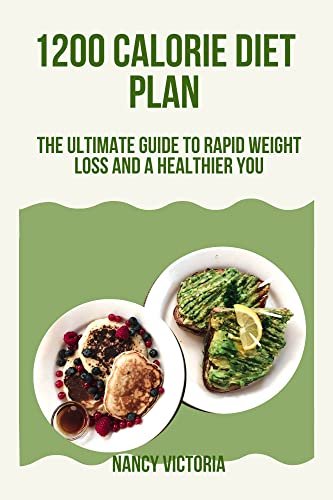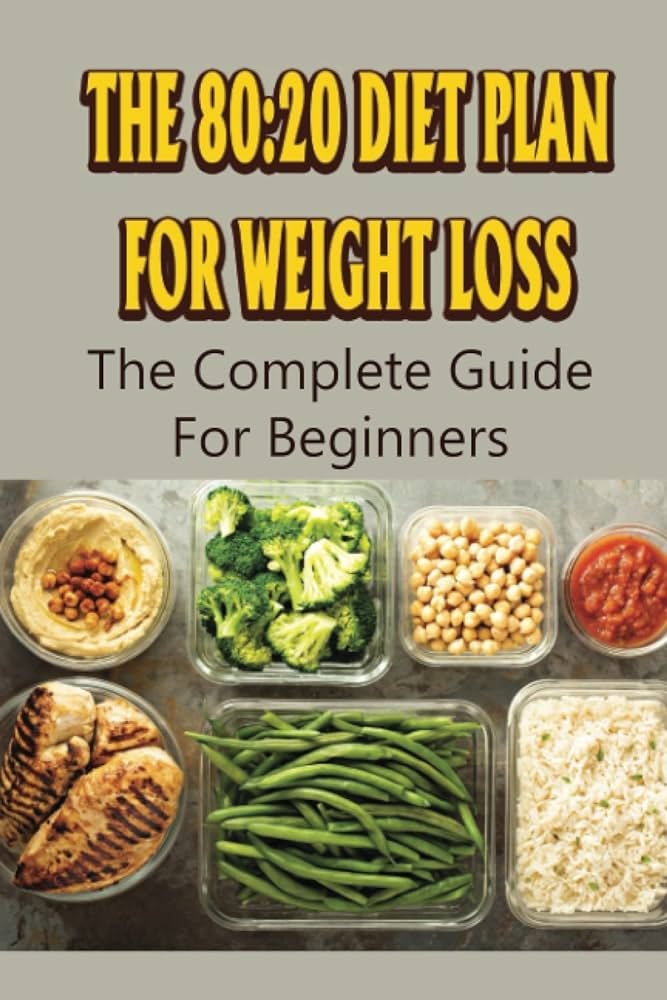Are you tired of struggling to lose weight? Look no further! “The Ultimate Guide to a Weight Loss Diet Plan” is here to help you achieve your fitness goals. This comprehensive guide provides you with everything you need to know about creating a successful weight loss diet plan. From understanding the importance of portion control to discovering the best foods to include in your meals, this guide offers valuable tips to kick-start your weight loss journey. Forget about fad diets and restrictive eating – mounjaro weight loss diet plan focuses on sustainable changes that will lead to long-term results. Get ready to embrace a healthier lifestyle and say goodbye to those extra pounds for good!

This image is property of Amazon.com.
1. Understanding Weight Loss Diet
1.1 What is a Weight Loss Diet?
A weight loss diet refers to a specific eating plan that is designed to help individuals shed excess weight and improve their overall health. It typically involves making conscious choices about the types and quantities of food consumed in order to create a calorie deficit, meaning you consume fewer calories than you burn. This prompts your body to utilize stored fat as a source of energy, leading to weight loss.
1.2 Why is Weight Loss Diet Important?
Maintaining a healthy weight is crucial for overall well-being and reducing the risk of chronic diseases such as heart disease, diabetes, and certain cancers. A weight loss diet is important because it enables you to not only shed excess weight but also improve your body composition by reducing body fat while preserving lean muscle mass. It also positively impacts various aspects of your health, including blood pressure, cholesterol levels, and blood sugar control.
1.3 Benefits of a Weight Loss Diet Plan
Following a well-designed weight loss diet plan offers numerous benefits beyond just shedding pounds. It can boost your self-confidence and improve your body image, leading to enhanced mental well-being. Additionally, achieving your weight loss goals can also increase your energy levels, improve sleep quality, and alleviate joint pain caused by excess weight. By adopting healthy eating habits and making sustainable lifestyle changes, you can experience long-term weight maintenance and overall better health.
2. Setting Weight Loss Goals
2.1 Importance of Goal Setting
Setting clear and realistic weight loss goals is essential for success on your weight loss journey. It provides you with a roadmap to follow and keeps you focused and motivated. By having a target to work towards, you can track your progress and celebrate milestones along the way. Goal setting also helps you break down your weight loss journey into manageable steps, making it less overwhelming and more attainable.
2.2 How to Set Realistic Weight Loss Goals
When setting weight loss goals, it is important to be realistic and avoid setting unattainable expectations. Start by determining your ideal weight range based on your body mass index (BMI) and consult with a healthcare professional if needed. Aim to lose 1-2 pounds per week, as this is considered a healthy and sustainable rate of weight loss. Break your overall weight loss goal into smaller, achievable objectives and establish a timeline for each milestone.
2.3 Tracking Progress
To stay motivated and accountable, it is crucial to track your progress regularly. Keep a record of your weight, body measurements, and any other relevant metrics. This will allow you to see your progress over time and make any necessary adjustments to your weight loss plan. Celebrate your achievements and acknowledge the effort you have put into reaching each milestone. Tracking your progress not only keeps you motivated but also helps you identify any patterns or areas that may require additional attention.

This image is property of Amazon.com.
3. Creating a Healthy Eating Plan
3.1 Determining Calorie Needs
3.2 Choosing Nutrient-Rich Foods
3.3 Incorporating Whole Grains
3.4 Including Lean Proteins
3.5 Adding Fruits and Vegetables
3.6 Balancing Macronutrients
3.7 Hydration and Water Intake
Creating a healthy eating plan is essential for sustainable weight loss. Here are some important aspects to consider while developing your personalized weight loss diet:
3.1 Determining Calorie Needs
To lose weight, you need to create a calorie deficit. Start by calculating your daily calorie needs based on factors such as your age, gender, weight, height, and activity level. This will give you a baseline for how many calories to consume each day in order to lose weight effectively.
3.2 Choosing Nutrient-Rich Foods
When it comes to weight loss, the quality of the food you consume is important. Focus on incorporating nutrient-rich foods into your diet that provide essential vitamins, minerals, and fiber. Opt for whole foods like fruits, vegetables, whole grains, lean proteins, and healthy fats.
3.3 Incorporating Whole Grains
Whole grains are an excellent source of fiber, which aids in digestion and helps control hunger. Include foods like whole wheat bread, brown rice, quinoa, and oats in your meals. These complex carbohydrates provide sustained energy and can help you feel fuller for longer periods of time.
3.4 Including Lean Proteins
Protein is an essential macronutrient that plays a crucial role in weight loss. It helps promote feelings of satiety, preserves muscle mass, and aids in repairing and building tissues. Incorporate lean protein sources such as chicken, turkey, fish, tofu, legumes, and low-fat dairy products into your diet.
3.5 Adding Fruits and Vegetables
Fruits and vegetables are rich in vitamins, minerals, and antioxidants while being low in calories. They provide essential nutrients and fiber to support overall health and weight loss. Aim to include a variety of colorful fruits and vegetables in your meals to maximize nutritional benefits.
3.6 Balancing Macronutrients
Finding the right balance of macronutrients (carbohydrates, protein, and fat) is important for weight loss. Each macronutrient serves a specific purpose in your body, and finding the right proportion for your needs can help optimize your weight loss results. Experiment with different ratios and consult with a registered dietitian if needed.
3.7 Hydration and Water Intake
Drinking an adequate amount of water is crucial for weight loss. It helps maintain proper bodily functions, aids in digestion, and promotes feelings of fullness. Aim to drink at least 8 glasses (64 ounces) of water per day and hydrate yourself throughout the day. Avoid sugary drinks and opt for water, herbal tea, or infused water instead.
4. Understanding Portion Control
4.1 Importance of Portion Control
4.2 Strategies for Portion Control
Understanding portion control is vital for achieving and maintaining weight loss goals. It involves being mindful of the amount of food you consume in a single sitting. Here are some strategies to help you practice portion control effectively:
4.1 Importance of Portion Control
Portion control is crucial because it helps prevent overeating and allows you to maintain a calorie deficit. It helps you learn to listen to your body’s hunger and fullness cues, preventing unnecessary weight gain. By being mindful of portion sizes, you can ensure that you are not consuming more calories than your body needs.
4.2 Strategies for Portion Control
- Use smaller plates and bowls to visually trick your brain into perceiving larger quantities of food.
- Use measuring cups or a food scale to accurately portion out your meals and snacks.
- Divide your plate into quarters, dedicating half of it to non-starchy vegetables, one-quarter to lean protein, and one-quarter to whole grains or starchy vegetables.
- Eat slowly and savor each bite, allowing your brain to register feelings of fullness.
- Avoid eating straight from food packages, as it is easy to lose track of portion sizes.
- Opt for single servings of snacks or pre-portion snacks into small containers to avoid mindlessly consuming larger quantities.
- Listen to your body’s hunger and fullness cues and stop eating when you are satisfied, not overly stuffed.
By implementing these strategies, you can practice portion control and maintain a healthy balance of calories to support your weight loss journey.

This image is property of Amazon.com.
5. Managing Hunger and Food Cravings
5.1 Understanding Hunger Signals
5.2 Strategies to Curb Hunger
5.3 Dealing with Food Cravings
Managing hunger and food cravings is essential for sticking to your weight loss diet plan. Here are some strategies to help you navigate these challenges:
5.1 Understanding Hunger Signals
Understanding your body’s hunger signals allows you to differentiate between physical hunger and emotional or psychological cravings. Physical hunger typically occurs when your body needs nourishment and sustenance. It is often felt as a growling or emptiness in the stomach. Emotional cravings, on the other hand, are often triggered by stress, boredom, or other emotional factors.
5.2 Strategies to Curb Hunger
To curb hunger, consider the following strategies:
- Eat regular meals and snacks to maintain a stable blood sugar level and avoid extreme hunger.
- Include protein and fiber-rich foods in your meals, as they help keep you full for longer periods of time.
- Stay hydrated throughout the day, as thirst can sometimes be mistaken for hunger.
- Incorporate healthy fats into your diet, such as avocados, nuts, and olive oil, as they contribute to feelings of satiety.
- Practice mindful eating by focusing on the taste, texture, and satisfaction derived from each bite.
- Manage stress through relaxation techniques like deep breathing, meditation, or engaging in enjoyable activities.
5.3 Dealing with Food Cravings
It is natural to experience food cravings, especially when you are restricting certain foods or following a calorie deficit diet. Here are some strategies to help you manage and overcome food cravings:
- Distract yourself by engaging in a hobby, going for a walk, or chatting with a friend.
- Practice portion control by allowing yourself to indulge in a small portion of the food you crave rather than completely depriving yourself.
- Keep healthy alternatives on hand to satisfy cravings, such as fresh fruit, Greek yogurt, or a handful of nuts.
- Delay satisfying the craving for a short period of time and reevaluate whether it is a genuine desire or simply a passing craving.
By understanding hunger signals and implementing strategies to curb hunger and manage cravings, you can stay on track with your weight loss goals while also maintaining a healthy relationship with food.
6. Meal Planning and Preparation
6.1 Benefits of Meal Planning
6.2 How to Meal Plan
6.3 Tips for Meal Preparation
Meal planning and preparation are key components of a successful weight loss diet plan. Here’s why they are important and how you can incorporate them into your routine:
6.1 Benefits of Meal Planning
Meal planning offers numerous benefits, including:
- Saves time: Planning meals in advance eliminates the need to make last-minute decisions or scramble for ingredients.
- Reduces stress: By knowing what meals to prepare in advance, you can avoid the stress of not knowing what to eat or resorting to unhealthy options.
- Supports portion control: Through meal planning, you can ensure that your meals are portioned correctly and meet your calorie and nutritional requirements.
- Helps with grocery shopping: Planning your meals ahead of time allows you to create a comprehensive grocery list, helping you save money and avoid impulse purchases.
- Encourages dietary variety: By planning your meals, you can incorporate a wider range of foods and flavors, making your eating experience more enjoyable.
6.2 How to Meal Plan
To start meal planning, follow these steps:
- Determine your calorie and macronutrient needs based on your weight loss goals.
- Assess your schedule and identify your busiest days or times when you may need quick or pre-prepared meals.
- Research healthy recipes and meal ideas that align with your dietary preferences and weight loss goals.
- Create a weekly meal plan that includes breakfast, lunch, dinner, and snacks for each day.
- Make a detailed grocery list based on your meal plan, ensuring you have all the necessary ingredients.
6.3 Tips for Meal Preparation
Meal preparation can help streamline your week and make healthy eating more convenient. Consider these tips to simplify meal preparation:
- Set aside a specific time each week for meal preparation, such as Sunday afternoon or evenings.
- Choose recipes that can be easily batch-cooked or prepared in advance.
- Pre-cut vegetables, wash fruits, and portion out ingredients to save time during meal assembly.
- Invest in quality food storage containers to keep meals fresh and easily accessible.
- Label and organize your pre-prepared meals in the refrigerator or freezer to make them easily identifiable.
- Consider utilizing kitchen gadgets like a slow cooker, pressure cooker, or air fryer to simplify meal preparation.
By incorporating meal planning and preparation into your routine, you can save time, reduce stress, and ensure that healthy, nourishing meals are readily available throughout the week.

This image is property of Amazon.com.
7. Importance of Physical Activity
7.1 Role of Exercise in Weight Loss
7.2 Types of Physical Activity
7.3 Incorporating Exercise into Daily Routine
Physical activity plays a vital role in weight loss and overall well-being. Here’s why it is important and how you can incorporate it into your daily routine:
7.1 Role of Exercise in Weight Loss
While diet plays a crucial role in weight loss, exercise is equally important. Regular physical activity helps burn calories, increase metabolism, and build lean muscle mass. It also provides various mental and emotional benefits, including improved mood, reduced stress, and increased energy levels.
7.2 Types of Physical Activity
Incorporating a mix of cardiovascular exercises, strength training, and flexibility exercises into your routine is ideal for weight loss and overall fitness. Consider the following types of physical activity:
- Cardiovascular exercises: These include activities that get your heart rate up and increase your breathing rate, such as brisk walking, jogging, cycling, swimming, or dancing. Aim for at least 150 minutes of moderate-intensity aerobic activity per week.
- Strength training: Engage in exercises that target major muscle groups, such as weightlifting, resistance band exercises, or bodyweight exercises like push-ups and squats. Strength training helps build muscle, which increases metabolism and enhances weight loss.
- Flexibility exercises: Stretching exercises like yoga or Pilates not only improve flexibility, but also enhance overall mobility and help prevent injuries.
7.3 Incorporating Exercise into Daily Routine
Finding ways to incorporate physical activity into your daily routine is essential. Consider these strategies to make exercise a regular part of your life:
- Schedule specific exercise sessions into your daily or weekly calendar.
- Find activities you enjoy to make exercise more fun and sustainable.
- Incorporate physical activity into your daily routine, such as taking the stairs instead of the elevator, walking or biking to work, or going for a walk during your lunch break.
- Utilize home workout videos or fitness apps for convenience and flexibility.
- Find a workout buddy or join a fitness class for added motivation and accountability.
- Gradually increase the intensity and duration of your workouts to challenge your body and continue progressing.
Remember, consistency is key when it comes to exercise. Aim for at least 150 minutes of aerobic activity and two or more strength training sessions per week to maximize weight loss benefits and improve overall fitness.
8. Tracking and Monitoring
8.1 Importance of Tracking
8.2 Food Diary
8.3 Weight and Measurements
8.4 Self-Monitoring
Tracking and monitoring your progress is an essential aspect of a successful weight loss journey. Here’s why it’s important and how you can do it effectively:
8.1 Importance of Tracking
Tracking your food intake, weight, and measurements can provide valuable insight into your habits and progress. It helps you identify patterns, make necessary adjustments to your eating plan, and stay accountable to your weight loss goals. Tracking also serves as a motivational tool by allowing you to see tangible evidence of your hard work.
8.2 Food Diary
Keeping a food diary is a powerful tool for understanding your eating habits and identifying areas for improvement. Write down everything you eat and drink throughout the day, including portion sizes and any condiments or extras. This will help you become more mindful of your food choices and uncover potential triggers for overeating or emotional eating.
8.3 Weight and Measurements
Tracking your weight and measurements allows you to monitor your progress over time. Weigh yourself regularly (e.g., once a week) and record your measurements, such as waist circumference or body fat percentage. Keep in mind that weight can fluctuate due to factors like water retention or muscle gain, so focus on overall trends rather than day-to-day fluctuations.
8.4 Self-Monitoring
In addition to tracking food intake and physical changes, self-monitoring involves paying attention to your thoughts, feelings, and behaviors in relation to food and exercise. Reflecting on your experiences can help you identify emotional triggers, tendencies to overeat, or any negative self-talk that may hinder your progress. Stay aware of your progress, celebrate successes, and address any setbacks with self-compassion and a growth mindset.
By tracking and monitoring your food intake, weight, measurements, and self-reflection, you can gain valuable insights and make data-driven decisions to support your weight loss goals.

This image is property of images.thalia.media.
9. Building a Support System
9.1 Importance of Support
9.2 Finding Support
9.3 Role of Accountability
Building a support system is crucial for maintaining motivation and staying committed to your weight loss goals. Here’s why it’s important and how you can find the support you need:
9.1 Importance of Support
Embarking on a weight loss journey can be challenging, and having a support system can make a world of difference. Support from family, friends, or professionals provides encouragement, accountability, and practical assistance. It helps reduce feelings of isolation and increases your likelihood of success.
9.2 Finding Support
Finding a support system can involve various avenues, such as:
- Share your weight loss goals with your close family and friends, explaining how they can support you. Their encouragement and understanding can make a significant impact.
- Seek out support groups or online communities focused on weight loss or healthy living. Being a part of a like-minded community can provide inspiration, tips, and a sense of belonging.
- Consider working with a registered dietitian or a certified personal trainer who specializes in weight management. They can provide expert guidance, accountability, and personalized support tailored to your specific needs.
- Engage in regular check-ins or join weight loss programs that provide ongoing support and resources.
9.3 Role of Accountability
Accountability is a key component of staying on track with your weight loss goals. Having someone to help keep you accountable can provide an extra layer of motivation and support. Consider the following strategies:
- Find a weight loss buddy with similar goals and journey. Share your progress, setbacks, and strategies to stay motivated.
- Work with a personal trainer or participate in group fitness classes. The scheduled sessions and guidance from fitness professionals can help you stay accountable to your exercise routine.
- Keep a food diary and share it with someone you trust, such as a friend, family member, or healthcare professional. This helps you stay mindful of your food choices and promotes transparency and accountability.
By surrounding yourself with a supportive network and embracing accountability, you can strengthen your resolve, overcome obstacles, and achieve long-term success in your weight loss journey.
10. Managing Setbacks and Staying Motivated
10.1 Understanding Setbacks
10.2 Strategies for Overcoming Setbacks
10.3 Staying Motivated during the Weight Loss Journey
Encountering setbacks is a normal part of any weight loss journey. It’s important to have strategies in place to overcome obstacles and stay motivated. Here’s how you can manage setbacks and stay on track:
10.1 Understanding Setbacks
Setbacks are temporary hurdles that can hinder your progress or lead to a sense of discouragement. They may include weight plateaus, emotional challenges, or a temporary lapse in healthy habits. It’s important to understand that setbacks are normal and a part of the process. Adopting a growth mindset allows you to learn from setbacks and continue moving forward.
10.2 Strategies for Overcoming Setbacks
To overcome setbacks, consider the following strategies:
- Reflect on the setback: Identify the factors contributing to the setback and learn from them. This might involve reassessing your goals, adjusting your approach, or seeking support.
- Stay positive and practice self-compassion: Recognize that setbacks do not define you or your worth. Be kind to yourself and focus on the progress you have made so far.
- Seek support: Reach out to your support system for guidance and encouragement. They can provide valuable insight and help you regain focus.
- Reevaluate your goals and strategies: Take a step back and assess if your goals are realistic or if your strategies need modification. Make necessary adjustments and create a plan to move forward.
- Celebrate small victories: Acknowledge and celebrate your accomplishments, regardless of their size. This boosts your motivation and reminds you of your progress.
10.3 Staying Motivated during the Weight Loss Journey
Maintaining motivation throughout your weight loss journey can be challenging. Here are some strategies to stay motivated:
- Set non-scale-related goals: Focus on other aspects of your health and fitness, such as increasing strength, improving flexibility, or running a 5K. These goals provide a broader sense of achievement beyond the number on the scale.
- Find inspiration: Follow social media accounts or websites that provide healthy recipes, success stories, and motivational content. Surround yourself with positive influences that reinforce your commitment.
- Reward yourself: Set up a reward system for reaching milestones or achieving specific goals. Treat yourself to non-food-related rewards, such as a massage, new workout gear, or a day off from chores.
- Practice positive self-talk: Replace negative self-talk with positive affirmations and remind yourself of your capabilities and progress.
- Visualize success: Create a mental image of yourself at your desired weight and focus on the positive feelings associated with achieving your goals. Visualizing success can increase motivation and confidence.
By understanding setbacks as part of the process, implementing strategies to overcome them, and staying motivated throughout your weight loss journey, you can overcome obstacles and successfully reach your goals.
In conclusion, embarking on a weight loss diet plan requires a comprehensive approach that encompasses understanding the fundamentals of weight loss, setting realistic goals, creating a healthy eating plan, mastering portion control, managing hunger and cravings, planning and preparing meals, incorporating physical activity, tracking progress, building a support system, and staying motivated. By following these guidelines and making sustainable lifestyle changes, you can achieve weight loss success, improve your health, and enhance your overall well-being. Remember, it’s a journey, and with consistency and dedication, you can reach your desired weight and maintain a healthier lifestyle in the long run.